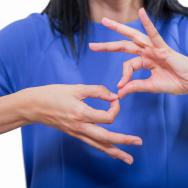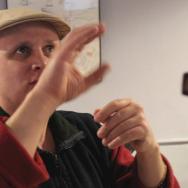If you hear someone say “John and Mary kiss,” you’d likely imagine a single symmetrical action. But hear them say “John and Mary kiss each other,” and you may construe an entirely different picture—one in which the parties reciprocate with two separate actions, kissing the other’s hand.
A distinction this subtle might not seem important, yet it appears across nearly all spoken languages.
In fact, this distinction may be intrinsic to the very development of language, according to new research co-authored by a leading psychologist at the University of Chicago. Published May 28 in the Proceedings of the National Academy of Science, the study found that sign language users in Nicaragua also distinguished between the concepts of symmetry and reciprocity—despite having developed their language in isolation.
Less than a half-century old, Nicaraguan Sign Language offered researchers their first chance to observe the growth of a new language in real time. In the mid-1970s, a group of about 50 deaf children were brought together to a school for special education in Managua, the country’s capital. Because deaf individuals in Nicaragua had had almost no prior opportunities to interact, the founding of the school created a situation for them to develop language without the influence of existing languages.
That such fine linguistic differences exist in a young language suggests that these properties are universal. The study also found the distinction among a handful of homesigners, deaf individuals who interact only with hearing individuals.
“If language were wiped out tomorrow and people had to reinvent it, I bet they would still distinguish between symmetrical and reciprocal events,” said study co-author Susan Goldin-Meadow, who has helped define the fields of gesture and non-verbal communication. “Other properties of language might not be reinvented, but this distinction appears to be so fundamental to human language that it would be.”
The Beardsley Ruml Distinguished Service Professor in the Departments of Psychology and Comparative Human Development, Goldin-Meadow produced the study with Lila Gleitman of the University of Pennsylvania, Ann Senghas of Barnard College, Molly Flaherty of Swarthmore College and Marie Coppola of the University of Connecticut.
The researchers studied 27 deaf individuals in Nicaragua, four of whom were adult homesigners who each developed a gesture language outside of the signing community. Ranging in age from 18 to 45, each participant watched a series of video clips showing actions that could be construed as symmetrical (e.g., high-fiving) or reciprocal (e.g., punching). Participants were then asked in gesture or sign to describe those videos.
All the signers in the study made formal distinctions in their descriptions despite the fact that, in the videos, the reciprocal events (punching) looked just as symmetrical as the symmetrical events (high-fiving). For example, signers used a two-handed symmetrical form to represent two people high-fiving, but used two one-handed asymmetrical forms, produced sequentially, to represent two people punching each other at the same moment.
This type of evidence can help researchers figure out the conditions under which properties of language emerge. A property that a homesigner develops, for example, would likely emerge in all human communication systems—even in the absence of a communication partner or a language model. Other language properties might require a partner, or a structured learning process to ensure they are passed down from generation to generation.
To further this field of research, Goldin-Meadow hopes to study if and when babies begin to distinguish between events that can be construed as symmetrical or reciprocal.
But why is such a distinction so omnipresent in human languages? That’s a question researchers still can’t answer.
“There are many other cognitive structures that we don’t bother to encode in our language,” Goldin-Meadow said. “Our study can’t explain why languages distinguish between symmetrical and reciprocal events, but it does tell us that this distinction is important to the human mind and to communication.”
Citation: “The emergence of the formal category ‘symmetry’ in a new sign language.” Gleitman et al., Proceedings of the National Academy of Science, May 28, 2019, DOI: 10.1073/pnas.1819872116.
Funding: National Institute of Child Health and Human Development, National Science Foundation, Radcliffe Institute for Advanced Study Fellowship, National Institute on Deafness and Other Communication Disorders, National Science Foundation Graduate Research Fellowship, British Academy Newton Fellowship, Swarthmore College Faculty Research Support Grant

